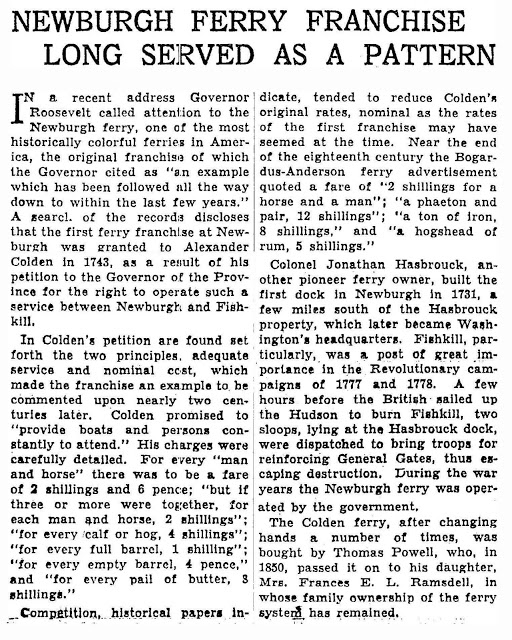The New York Times
Published: March 23, 1930
IN a recent address Governor Roosevelt called attention to the Newburgh ferry, one of the most historically colorful ferries in America, the original franchise of which Governor cited as “an example which has been followed all the way down to within the last few years.” A search of the records discloses that the first ferry franchise at Newburgh was granted to Alexander Colden in 1743, as a result of his petition to the Governor of the Province for the right to operate such & service between Newburgh and Fishkill.
In Colden’s petition are found set forth the two principles, adequate services and nominal cost, which made the franchise an example to be commented upon nearly two centuries later. Colden promised to “provide boats and persons constantly to attend.” His charges were carefully detailed. For every “man and a horse” there will be a fare of 2 shillings and 6 pence; “but if three or more were together, for each man and horse, 2 shillings”; “for every calf or hog, 4 shillings”; “for every full barrel, 1 shilling”; “for every empty barrel, 4 pence,” and “for every pail of butter, 3 shillings.” Competition, historical papers indicate, tended to reduce Colden’s original rates, nominal as the rates of the first franchise may have seemed at the time. Near the end of the eighteenth century the Bogardus-Anderson ferry advertisement quoted a fare of “2 shillings for a horse and a man”; “a phaeton and pair, 12 shillings”; “a ton of iron, 8 shillings,” and “a hogshead of rum, 5 shillings.”
Colonel Jonathan Hasbrouck, another pioneer ferry owner, built the first dock in Newburgh in 1731, a few miles south of the Hasbrouck property, which later became Washington’s headquarters. Fishkill, particularly, was a post of great importance in the Revolutionary campaigns of 1777 and 1778. A few hours before the British· sailed up the Hudson to burn Fishkill, two sloops, lying at the Hasbrouck dock, were dispatched to bring troops for reinforcing General Gates, thus escaping destruction. During the war years the Newburgh ferry was operated by the government.
The Colden ferry, after changing hands a. number of times, was bought by Thomas Powell, who, in 1850, passed it on to his daughter, Mrs. Frances E. L. Ramsdell, in whose family ownership of the ferry system has remained

